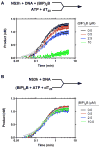Mechanism and specificity of a symmetrical benzimidazolephenylcarboxamide helicase inhibitor
- PMID: 20108979
- PMCID: PMC2832472
- DOI: 10.1021/bi901974a
Mechanism and specificity of a symmetrical benzimidazolephenylcarboxamide helicase inhibitor
Abstract
This study examines the effects of 1-N,4-N-bis[4-(1H-benzimidazol-2-yl)phenyl]benzene-1,4-dicarboxamide ((BIP)(2)B) on the NS3 helicase encoded by the hepatitis C virus (HCV). Molecular beacon-based helicase assays were used to show that (BIP)(2)B inhibits the ability of HCV helicase to separate a variety of RNA and DNA duplexes with half-maximal inhibitory concentrations ranging from 0.7 to 5 microM, depending on the nature of the substrate. In single turnover assays, (BIP)(2)B only inhibited unwinding reactions when it was preincubated with the helicase-nucleic acid complex. (BIP)(2)B quenched NS3 intrinsic protein fluorescence with an apparent dissociation constant of 5 microM, and in the presence of (BIP)(2)B, HCV helicase did not appear to interact with a fluorescent DNA oligonucleotide. In assays monitoring HCV helicase-catalyzed ATP hydrolysis, (BIP)(2)B only inhibited helicase-catalyzed ATP hydrolysis in the presence of intermediate concentrations of RNA, suggesting RNA and (BIP)(2)B compete for the same binding site. HCV helicases isolated from various HCV genotypes were similarly sensitive to (BIP)(2)B, with half-maximal inhibitory concentrations ranging from 0.7 to 2.4 microM. (BIP)(2)B also inhibited ATP hydrolysis catalyzed by related helicases from Dengue virus, Japanese encephalitis virus, and humans. (BIP)(2)B appeared to bind the HCV and human proteins with similar affinity (K(i) = 7 and 8 microM, respectively), but it bound the flavivirus proteins up to 270 times more tightly. Results are discussed in light of a molecular model of a (BIP)(2)B-HCV helicase complex, which is unable to bind nucleic acid, thus preventing the enzyme from separating double-stranded nucleic acid.
Figures







Similar articles
-
Structure and function of hepatitis C virus NS3 helicase.Curr Top Microbiol Immunol. 2000;242:171-96. doi: 10.1007/978-3-642-59605-6_9. Curr Top Microbiol Immunol. 2000. PMID: 10592661 Review.
-
Real-time monitoring of RNA helicase activity using fluorescence resonance energy transfer in vitro.Biochem Biophys Res Commun. 2010 Feb 26;393(1):131-6. doi: 10.1016/j.bbrc.2010.01.100. Epub 2010 Feb 1. Biochem Biophys Res Commun. 2010. PMID: 20117090
-
Primuline derivatives that mimic RNA to stimulate hepatitis C virus NS3 helicase-catalyzed ATP hydrolysis.J Biol Chem. 2013 Jul 5;288(27):19949-57. doi: 10.1074/jbc.M113.463166. Epub 2013 May 23. J Biol Chem. 2013. PMID: 23703611 Free PMC article.
-
In vitro selection of RNA aptamers against the HCV NS3 helicase domain.Oligonucleotides. 2004;14(2):114-29. doi: 10.1089/1545457041526335. Oligonucleotides. 2004. PMID: 15294075
-
The hepatitis C virus NS3 protein: a model RNA helicase and potential drug target.Curr Issues Mol Biol. 2007 Jan;9(1):1-20. Curr Issues Mol Biol. 2007. PMID: 17263143 Free PMC article. Review.
Cited by
-
Antiviral drugs against hepatitis C virus.Genet Vaccines Ther. 2011 Jun 23;9:11. doi: 10.1186/1479-0556-9-11. Genet Vaccines Ther. 2011. PMID: 21699699 Free PMC article.
-
Identification and analysis of hepatitis C virus NS3 helicase inhibitors using nucleic acid binding assays.Nucleic Acids Res. 2012 Sep 1;40(17):8607-21. doi: 10.1093/nar/gks623. Epub 2012 Jun 27. Nucleic Acids Res. 2012. PMID: 22740655 Free PMC article.
-
Fluorescent primuline derivatives inhibit hepatitis C virus NS3-catalyzed RNA unwinding, peptide hydrolysis and viral replicase formation.Antiviral Res. 2012 Nov;96(2):245-55. doi: 10.1016/j.antiviral.2012.08.006. Epub 2012 Aug 25. Antiviral Res. 2012. PMID: 22940425 Free PMC article.
-
Novel benzoxazole inhibitor of dengue virus replication that targets the NS3 helicase.Antimicrob Agents Chemother. 2013 Apr;57(4):1902-12. doi: 10.1128/AAC.02251-12. Epub 2013 Feb 12. Antimicrob Agents Chemother. 2013. PMID: 23403421 Free PMC article.
-
Inhibition of hepatitis C virus replication and viral helicase by ethyl acetate extract of the marine feather star Alloeocomatella polycladia.Mar Drugs. 2012 Apr;10(4):744-761. doi: 10.3390/md10040744. Epub 2012 Mar 28. Mar Drugs. 2012. PMID: 22690141 Free PMC article.
References
-
- Phoon CW, Ng PY, Ting AE, Yeo SL, Sim MM. Biological evaluation of hepatitis C virus helicase inhibitors. Bioorg Med Chem Lett. 2001;11:1647–1650. - PubMed
Publication types
MeSH terms
Substances
Grants and funding
LinkOut - more resources
Full Text Sources
Miscellaneous

